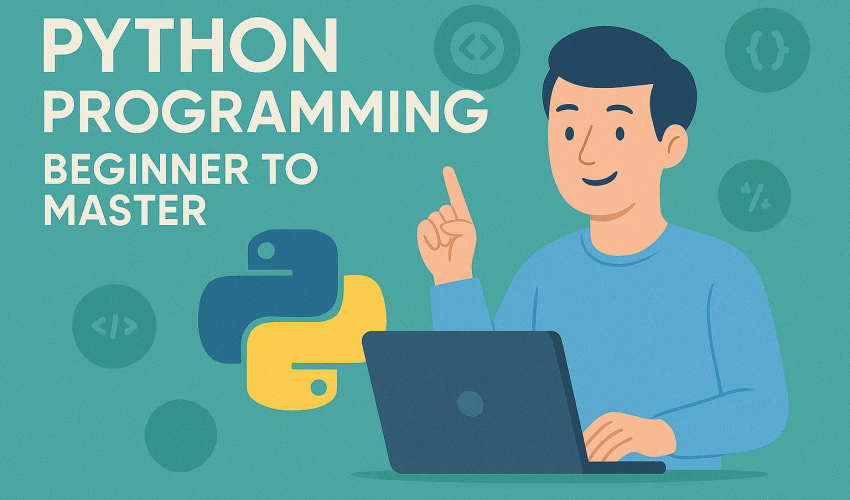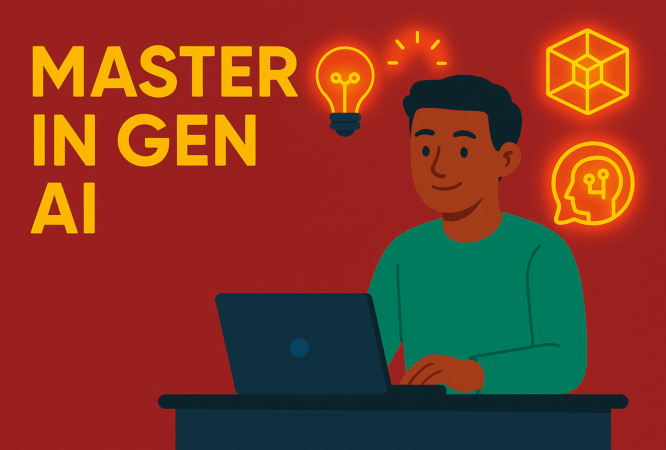Learn Python Programming – Beginner to Master

About the Course
This Python Programming course provides a comprehensive journey from the fundamentals of programming to advanced topics like data analytics, web development with Django, and machine learning foundations using libraries like Pandas and NumPy. Designed for beginners and intermediate learners alike, the course begins with the core principles of programming and gradually builds up to real-world application development and data science.
It combines theoretical knowledge with practical skills through case studies and project work, empowering learners to build software solutions, analyze data, automate tasks, and develop web applications using Python.
Key outcomes include mastering Python syntax, object-oriented programming, data manipulation with Pandas and NumPy, web development with Django, and building machine learning models for real-world applications.
Python Course Syllabus
Complete Course – All Modules
Understanding different programming languages and their characteristics.
- What is Language?
- Types of languages
- Introduction to Translators
- Compiler
- Interpreter
- What is Scripting Language?
- Types of Script
- Programming Languages v/s Scripting Languages
- Difference between Scripting and Programming languages
- What is programming paradigm?
- Procedural programming paradigm
- Object Oriented Programming paradigm
Learn the fundamentals of Python programming language.
- What is Python?
- WHY PYTHON?
- History
- Features – Dynamic, Interpreted, Object oriented, Embeddable, Extensible, Large standard libraries, Free and Open source
- Why Python is General Language?
- Limitations of Python
- What is PSF?
- Python implementations
- Python applications
- Python versions
- PYTHON IN REALTIME INDUSTRY
- Difference between Python 2.x and 3.x
- Difference between Python 3.7 and 3.8
- Software Development Architectures
Set up Python development environment and explore IDEs.
- Python Distributions
- Download & Python Installation Process in Windows, Unix, Linux and Mac
- Online Python IDLE
- Python Real-time IDEs like Spyder, Jupyter Note Book, PyCharm, Rodeo, Visual Studio Code, ATOM, PyDev etc
Master the basic building blocks of Python programming.
- Python Implementation Alternatives/Flavors
- Keywords
- Identifiers
- Constants / Literals
- Data types
- Python VS JAVA
- Python Syntax
Understand various ways to execute Python code.
- Interactive Mode
- Scripting Mode
- Programming Elements
- Structure of a Python Program
- First Python Application
- Comments in Python
- Python File Extensions
- Setting Path in Windows
- Editing and Running Python Programs without IDE
- Editing and Running Python Programs using IDEs
- Inside Python
- Programmer’s View of the Interpreter
- Inside Interpreter
- Byte Code in Python
- Python Debugger
- Bytes Data Type
- Byte Array
- String Formatting in Python
- Math, Random, Secrets Modules
Learn about variables, scope, and data handling in Python.
- Introduction to Variables
- Initialization of Variables
- Local Variables
- Global Variables
- ‘global’ Keyword
- Input and Output Operations
- Data Conversion Functions (int(), float(), complex(), str(), chr(), ord())
Master all types of operators available in Python.
- Arithmetic Operators
- Comparison Operators
- Assignment Operators
- Logical Operators
- Bitwise Operators
- Shift Operators
- Membership Operators
- Identity Operators
- Ternary Operator
- Operator Precedence
- Difference between “is” vs “==”
Handle user input and output operations in Python.
- Input
- Command-line Arguments
Control program flow using conditional and loop statements.
- Conditional Control Statements
- if
- if-else
- if-elif-else
- Nested-if
- Loop Control Statements
- for
- while
- Nested Loops
- Branching Statements
- break
- continue
- pass
- return
- Case Studies
Explore Python’s built-in data structures and collections.
- Introduction to Data Structures
- Importance and Applications of Data Structures
- Types of Collections:
- Sequence (Strings, List, Tuple, Range)
- Non-sequence (Set, Frozen set, Dictionary)
- Strings:
- What is String?
- Representation and Processing
- Indexing, Slicing, and Iterators
- String Operators, Methods, and Functions
- String Immutability
- Case Studies
Master Python lists for storing and manipulating ordered data.
- What is List?
- Need for List Collection
- Creating Lists
- List Comprehension
- List Indices
- Indexing, Slicing, and Processing
- List Methods
- List Mutability
- Nested Lists
- zip() and unzip()
- Python Arrays
- Hardcopy, Shallow Copy, and Deep Copy
- Case Studies
Work with immutable sequences using Python tuples.
- What is Tuple?
- Creating Tuples
- Tuple Methods
- Tuple Immutability
- Processing Tuples (Indexing, Slicing)
- List vs. Tuple
- Case Studies
Handle unique collections of items using Python sets.
- What is Set?
- Creating Sets
- Difference between List and Set
- Iteration over Sets
- Accessing Set Elements
- Set Methods and Operations
- Union of Sets
- Python Frozen Set
- Difference between Set and Frozen Set
- Case Studies
Store and retrieve key-value pairs using Python dictionaries.
- What is Dictionary?
- Difference between List, Set, and Dictionary
- Creating Dictionaries
- Python Hashing
- Accessing Values in Dictionary
- Dictionary Methods and Functions
- Copying, Updating, and Deleting Dictionary Items
- Sorting Dictionary
- Dictionary Comprehension
- Case Studies
Create reusable code blocks and understand advanced function concepts.
- What is a Function?
- Advantages of Functions
- Syntax and Writing Functions
- Calling or Invoking Functions
- Classification of Functions
- No Arguments and No Return Value
- With Arguments and No Return Value
- With Arguments and With Return Value
- No Arguments and With Return Value
- Recursion
- Python Argument Types
- Default Arguments
- Positional Arguments
- Keyword Arguments
- Variable Arguments
- pass Keyword in Functions
- Lambda Functions/Anonymous Functions
- map(), filter(), reduce()
- Nested Functions
- Non-local and Global Variables
- Closures
- Decorators
- Generators
- Iterators
- Monkey Patching
Organize code into reusable modules for better project structure.
- Importance of Modular Programming
- What is a Module?
- Types of Modules (Pre-defined, User-defined)
- Creating User-defined Modules
- Functions-based Modules
- Class-based Modules
- Connecting Modules
- import Module
- from … import
- Module Alias/Renaming Module
- Built-in Properties of Module
Organize related modules into packages for large applications.
- Organizing Python Projects into Packages
- Types of Packages (Pre-defined, User-defined)
- Package vs. Folder
- __init__.py File
- Importing Packages
- PIP
- Introduction to PIP
- Installing PIP
- Installing and Uninstalling Python Packages
Master object-oriented programming concepts in Python.
- Procedural vs. Object-Oriented Programming
- Principles of OOP: Encapsulation, Abstraction (Data Hiding)
- Classes and Objects
- Defining Classes in Python
- Types of Variables (Instance Variables, Class Variables)
- Types of Methods (Instance Methods, Class Methods, Static Methods)
- Object Initialization
- self Reference Variable
- cls Reference Variable
- Access Modifiers (Private, Protected, Public)
- Property Class and Property() Object
- Encapsulation (Data Binding)
- Polymorphism: Method Overriding, Constructor Overriding, Method Overloading, Constructor Overloading, Operator Overloading
- Class Reusability (Composition, Aggregation, Inheritance)
- Inheritance (Single, Multi-level, Multiple, Hierarchical, Hybrid, Diamond Inheritance)
- Constructors in Inheritance
- Object Class
- super()
- Runtime Polymorphism
- Method Resolution Order (MRO)
- Duck Typing
- Concrete Methods in Abstract Base Class
- Difference between Abstraction & Encapsulation
- Inner Classes: Writing and Accessing Inner Class Members, Local and Complex Inner Classes
- Case Studies
Handle errors and exceptions gracefully in Python applications.
- What is an Exception?
- Why Exception Handling?
- Syntax Error vs. Runtime Error
- Common Exception Codes (AttributeError, ValueError, IndexError, TypeError, etc.)
- Handling Exceptions (try-except Block, Multi except, try-finally)
- Raising Custom/User-defined Exceptions
- Case Studies
Use pattern matching and text processing with regular expressions.
- Understanding Regular Expressions
- String vs. Regular Expression String
- re Module Functions
- match()
- search()
- split()
- findall()
- compile()
- sub()
- subn()
- Expressions Using Operators and Symbols
- Simple Character Matches
- Special Characters and Character Classes
- Data Extraction (Mobile Numbers, Email IDs, Passwords, URLs, Vehicle Numbers)
- Case Studies
Perform file and directory operations for data persistence.
- Introduction to files
- Opening files
- File modes
- Reading data from files
- Writing data into files
- Appending data into files
- Line count in Files
- CSV module
- Creating CSV files
- Reading from CSV files
- Writing into CSV files
- Object serialization – pickle module
- XML parsing
- JSON parsing
Implement logging for debugging and monitoring applications.
- Logging Levels
- Implement Logging
- Configure Log File in overwriting Mode
- Timestamp in the Log Messages
- Python Program Exceptions to the Log File
- Requirement of Our Own Customized Logger
- Features of Customized Logger
Work with dates, times, and calendar operations.
- How to use Date & Date Time class
- How to use Time Delta object
- Formatting Date and Time
- Calendar module
- Text calendar
- HTML calendar
Interact with the operating system through Python.
- Shell script commands
- Various OS operations in Python
- Python file system shell methods
- Creating files and directories
- Removing files and directories
- Shutdown and Restart system
- Renaming files and directories
- Executing system commands
Build concurrent applications with threading and multiprocessing.
- Introduction
- Multi-tasking v/s Multi-threading
- Threading module
- Creating threads
- Inheriting Thread class
- Using callable object
- Life cycle of threads
- Single-threaded application
- Multi-threaded application
- Can we call run() directly?
- Need to start() method
- Sleep()
- join()
- Synchronization
- Lock class
- acquire(), release() functions
- Case studies
Understand memory management and garbage collection.
- Introduction
- Importance of Manual garbage collection
- Self-reference objects garbage collection
- ‘gc’ module
- collect() method
- Threshold function
- Case studies
Connect and interact with databases using Python.
- Introduction to DBMS applications
- File based v/s DBMS
- Communicating with MySQL
- Python – MySQL connector
- connector module
- connect() methods
- Oracle Database
- Install cx_Oracle
- Cursor Object methods
- execute() methods
- executemany() methods
- fetchone()
- fetchmany()
- fetchall()
- Static queries v/s Dynamic queries
- Transaction management
- Case studies
Build networked applications using socket programming.
- What is sockets
- What is socket Programming
- The socket Module
- Server socket Methods
- Connecting to a server
- A simple server-client program
- Server
- Client
Create graphical user interfaces and graphics.
- Introduction to GUI programming
- Tkinter module
- Tk class
- Components / Widgets
- Label, Entry, Button, Combo, Radio
- Types of Layouts
- Handling events
- Widgets properties
- Case studies
Introduction to Python’s data analysis ecosystem.
- NumPy
- Introduction
- SciPy
- Introduction
- Arrays
- Datatypes
- Matrices
- N dimension arrays
- Indexing and Slicing
- Pandas
- Introduction
- Data Frames
- Merge, Join, Concatenate
- MatPlotLib
- Introduction
- Drawing plots
- Introduction to Machine learning
- Types of Machine Learning
- Introduction to Data Science
- Introduction to Python Django
Build full-stack web applications using Django framework.
- What is Web framework?
- Why Frameworks?
- Define MVT Design Pattern
- Difference between MVC and MVT
Get started with Pandas for data manipulation and analysis.
Configure your environment for effective Pandas development.
Master Pandas’ core data structures for effective data handling.
- Dimension & Description
- Series
- DataFrame
- Data Type of Columns
- Panel
Work with one-dimensional labeled arrays in Pandas.
- Series
- Create an Empty Series
- Create a Series from ndarray
- Create a Series from dict
- Create a Series from Scalar
- Accessing Data from Series with Position
- Retrieve Data Using Label (Index)
Master two-dimensional data structures with DataFrame operations.
- DataFrame
- Create DataFrame
- Create an Empty DataFrame
- Create a DataFrame from Lists
- Create a DataFrame from Dict of ndarrays / Lists
- Create a DataFrame from List of Dicts
- Create a DataFrame from Dict of Series
- Column Selection
- Column Addition
- Column Deletion
- Row Selection, Addition, and Deletion
Explore three-dimensional data structures in Pandas.
- Panel()
- Create Panel
- Selecting the Data from Panel
Learn basic operations and functionality in Pandas.
- DataFrame Basic Functionality
Generate descriptive statistics and summaries of your data.
- Functions & Description
- Summarizing Data
Apply functions to data in various ways for data transformation.
- Table-wise Function Application
- Row or Column Wise Function Application
- Element Wise Function Application
Learn to reindex data for alignment and organization.
- Reindex to Align with Other Objects
- Filling while Reindexing
- Limits on Filling while Reindexing
- Renaming
Iterate through DataFrames and Series efficiently.
- Iterating a DataFrame
- iteritems()
- iterrows()
- itertuples()
Sort data by labels and values for better organization.
- By Label
- Sorting Algorithm
Customize Pandas options for better display and functionality.
- get_option(param)
- set_option(param, value)
- reset_option(param)
- describe_option(param)
- option_context()
Select and index data using various methods for data access.
- .loc()
- .iloc()
- .ix()
- Use of Notations
Apply statistical functions for data analysis and insights.
- Percent_change
- Covariance
- Correlation
- Data Ranking
Apply window functions for time series analysis and rolling calculations.
- .rolling() Function
- .expanding() Function
- .ewm() Function
Perform aggregation operations on grouped data.
- Applying Aggregations on DataFrame
Handle missing data effectively in your datasets.
- Cleaning / Filling Missing Data
- Replace NaN with a Scalar Value
- Fill NA Forward and Backward
- Drop Missing Values
- Replace Missing (or) Generic Values
Group data and perform operations on grouped datasets.
- Split Data into Groups
- View Groups
- Iterating through Groups
- Select a Group
- Aggregations
- Transformations
- Filtration
Merge and join datasets for comprehensive data analysis.
- Merge Using ‘how’ Argument
Concatenate multiple datasets along different axes.
- Concatenating Objects
- Time Series
Work with date and time data in Pandas.
Handle time differences and duration calculations.
Work with categorical data types for memory efficiency.
- Object Creation
Create visualizations directly from Pandas DataFrames.
- Bar plot
- Histograms
- Box plots
- Area plot
- Scatter plot
- Pie Chart
Read from and write to various file formats.
- csv
Handle sparse data efficiently for memory optimization.
Learn about common pitfalls and best practices in Pandas.
Compare Pandas operations with SQL equivalents.
Get started with NumPy for numerical computing in Python.
Set up your NumPy development environment.
Understand the fundamental ndarray object in NumPy.
Work with different data types in NumPy arrays.
- Data Type Objects (dtype)
Explore important attributes of NumPy arrays.
- shape
- ndim
- itemsize
- flags
Learn different methods to create NumPy arrays.
- empty
- zeros
- ones
Create arrays from existing data sources.
- asarray
- frombuffer
- fromiter
Generate arrays from numerical ranges and sequences.
- arange
- linspace
- logspace
Access and manipulate array elements using indexing and slicing.
Master advanced indexing techniques for complex data selection.
- Integer Indexing
- Boolean Array Indexing
Understand broadcasting rules for operations on arrays of different shapes.
Iterate through NumPy arrays efficiently.
- Iteration
- Order
- Modifying Array Values
- External Loop
- Broadcasting Iteration
Manipulate array shapes and structures for data processing.
- reshape
- ndarray.flat
- ndarray.flatten
- ravel
- transpose
- ndarray.T
- swapaxes
- rollaxis
- broadcast
- broadcast_to
- expand_dims
- squeeze
- concatenate
- stack
- hstack and numpy.hstack
- vstack
- split and numpy.split
- hsplit
- vsplit
- resize
- append
- insert
- delete
- unique
Perform bitwise operations on NumPy arrays.
- bitwise_and
- bitwise_or
- invert
- left_shift
- right_shift
Work with string operations in NumPy arrays.
Apply mathematical functions to NumPy arrays.
- Trigonometric Functions
- Functions for Rounding
Perform arithmetic operations on NumPy arrays.
- reciprocal
- power
- mod
Calculate statistical measures using NumPy functions.
- amin and numpy.amax
- ptp
- percentile
- median
- mean
- average
- Standard Deviation
- Variance
Sort, search, and count elements in NumPy arrays.
- sort
- argsort
- lexsort
- argmax and numpy.argmin
- nonzero
- where
- extract
Handle byte order and endianness in NumPy arrays.
- ndarray.byteswap
Understand the difference between copies and views in NumPy.
- No Copy
- View or Shallow Copy
- Deep Copy
Work with matrix operations using NumPy’s matrix library.
- matlib.empty
- matlib.zeros
- matlib.ones
- matlib.eye
- matlib.identity
- matlib.rand
Perform linear algebra operations using NumPy.
- dot
- vdot
- inner
- matmul
- Determinant
- linalg.solve
Create visualizations using NumPy with Matplotlib.
- Sine Wave plot
- subplot
- bar
Create histograms using NumPy and Matplotlib.
- histogram
- plt
Learn to save and load NumPy arrays for persistent data storage.
- save
- savez
techpath
You might be interested in
- Live class
- Beginner
- 29 Students
- 16 lessons
- Live class
- Beginner
- 29 Students
- 10 lessons
- Live class
- Beginner
- 29 Students
- 10 lessons
- Live class
- Beginner
- 29 Students
- 10 lessons
Sign up to receive our latest updates
Get in touch
Address





